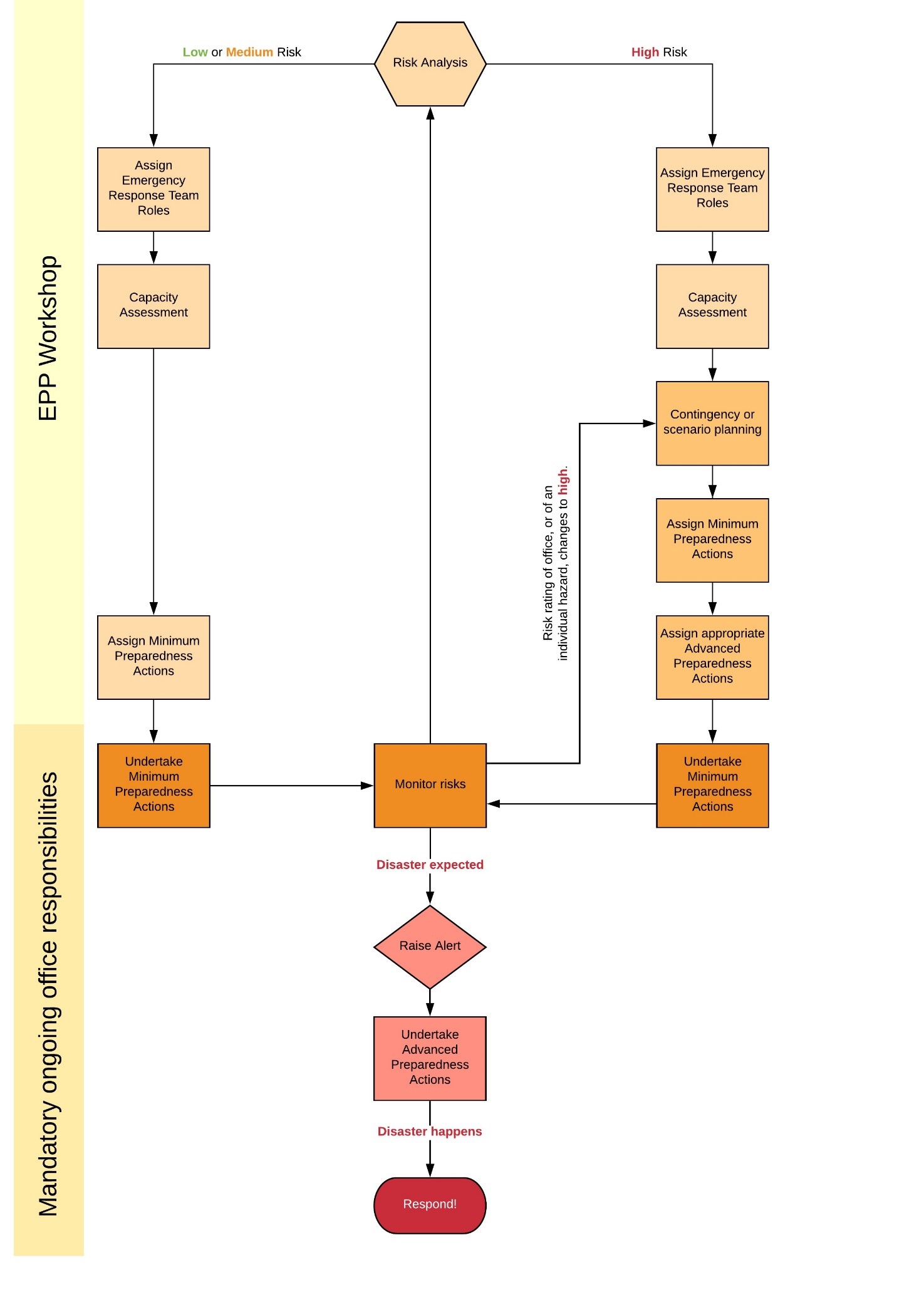9. Emergency Preparedness Planning (EPP)
Emergency preparedness planning is a scenario-based tool to prepare for potential emergencies. The objective of EPP is to create systems and structures that support CARE offices to achieve quality preparedness and response. This process should increase the capacity of offices to alleviate potential disaster impacts and improve the level of readiness to respond to emergencies.
CARE’s approach to disaster and climate risk reduction encompasses the full range of prevention, mitigation, preparedness and response measures to ensure both immediate needs in an emergency are met and underlying causes are addressed. Disaster and climate risk reduction must focus on taking pre-emptive measures to help communities avoid emergencies and become better equipped to reduce the impact of disasters.
CARE uses EPP as a critical component of its commitment to disaster risk management (DRM). For more information, refer to Chapter 6 – Disaster Risk Reduction
A CO that is well prepared for an emergency response should:
Checklist
- Identify high-risk situations and design programmatic interventions based on likely scenarios.
- Have an Emergency Response Team (ERT) in place and members familiar with the CARE Emergency Toolkit and Emergency Protocols.
- Identify at least three high-risk level disaster scenarios and develop mitigation, preparedness and response strategies.
- Have identified capacity gaps and established a Capacity Building Action Plan that includes staff and systems development needs.
- Identify the funding requirements to implement the Capacity Building Action Plan.
- Be able to realistically recognise its capacity and limitations.
- Be able to strengthen community capacities to reduce the effects of identified risk situations and be better prepared to respond.
- Confident enough to ‘raise the alarm’ in the event of an emergency and to provide best estimates of the situation.
- Be able to carry out rapid emergency needs assessment during the onset of emergency and provide timely information to CARE International for decision-making.
CARE has developed a set of comprehensive guidelines for emergency preparedness planning, which provides step-by-step instructions and guidance. These guidelines and workbook are available at Annex 37.1 (a-d) CARE Emergency Preparedness Planning Guidelines, and 37.2 (a-d) CARE Emergency Preparedness Planning Workbook. The Guidelines are to be used by all CARE offices. The planning guidelines include various annexes, which are referenced in the guidelines document, or included as separate annexes below. The annexes below also include Annex 37.13 (a-d) Cash Preparedness Guidance Note that is not yet reflected in the EPP guidelines.
See Chapter 3 of this toolkit for more information on addressing gender in emergencies in emergency preparedness, the CARE GiE guidance note series for guidance on gender in emergency preparedness, gender in brief, gender action plans & more. These are all also the CARE Emergency Preparedness Planning Guidelines as annexes.
All country offices regardless of risk ratings are required to review and implement every year the Minimum Preparedness Actions (MPAs) as found in Annex 37.8 (a-d).
The EPP process involves the following steps, depending on whether the country in question is low, medium or high/very high risk (see INFORM and Annex 37.1 (a-d) the Planning guidelines):

.
Checklist
- Undertake hazard identification and risk analysis to inform the emergency prepared planning. Collect information on historical disasters in the country and current trends related to migration patterns, emerging conflicts, food insecurity data, etc.
- Form the emergency response team (ERT) and sub-office structures to support emergency operations. Assign key roles to individuals on the team. A high risk office will require a more extensive emergency response team. Provide orientation to ERT members of basic concepts and emergency protocols.
- Develop a detailed inventory of office capacities using the CARE Capacity Assessment Questionnaire. Identify any capacity gaps.
- Undertake response planning appropriate to the level of risk. Consider possible responses to emergency scenarios and establish the basic elements of response strategies. Review again any capacity gaps based on the response planning. Consider:
- How to monitor hazards and risks
- Whether to work with partners (involve partners in the planning wherever possible)
- What modalities of response will be used (e.g. cash, in-kind, technical assistance, etc).
- How to ensure gender and inc
- Undertake action planning:
- Assign CARE’s mandate minimum preparedness actions to the relevant staff. This will not be limited to ERT members, and will include both programme and programme support staff (e.g. finance, procurement, logistics, etc).
- Identify and assign any additional minimum preparedness actions to address capacity gaps identified.
- Identify and assign any advanced preparedness actions which will be carried out if it becomes likely a response will be needed.
- Document and share the written plan using the CARE EPP Workbook and/or the Alert Platform (see below.
- Implement the minimum preparedness actions throughout the year.
- Undertake necessary risk monitoring throughout the year.
- Mainstream preparedness and mitigation actions in development projects.
- Review the plan at appropriate intervals (annually, for very high risk and high risk offices).
The actions above are shown in alternative format in the flowchart below:


CARE is part of the Alert Consortium, and in 2017 is piloting the use of the Alert Platform in the Philippines and Kenya. The Alert Platform is an online system for risk monitoring and emergency preparedness planning, with the potential to improve the efficiency and effectiveness of emergency preparedness planning. It allows for networked planning with partners and peers. Offices which are interested in also trialling the software can find out more here, or request further information from alert@careinternational.org.
The EPP should be incorporated in the CO’s management framework, including Long Range Strategic Plans, AOPs, and Individual Operating Plans (IOPs). The CO’s long-term strategies should be based on the disaster scenarios and emergency response strategies developed during the EPP process. The EPP should also inform development of the ERT members’ annual plans.
The CO AOP should include the capacity building action items identified through the EPP process, including:
Checklist
- Staff development needs, such as formal training sessions, temporary duty assignments (TDY), or experiential learning opportunities (ELO).
- Organisational capacity building needs, such as development/updating of manuals and procedures to enable quicker transition into emergency response mode.
- Infrastructure/equipment-related needs, such as purchase of equipment or setting up communication infrastructure.
For detailed information on security management frameworks, refer to Chapter 14- Safety and security.
Emergency preparedness plans and safety/security plans follow the same framework: both planning tools are based on identifying potential risks, and developing risk reduction strategies, standard operating procedures and contingency plans.
While the EPP considers disaster risks (floods, earthquakes, droughts, conflicts, etc.) that typically affect CARE beneficiaries, the SMF mainly considers risks to CARE staff and assets. Consequently, risk reduction strategies, standard operating procedures (protocols), and contingency plans for EPP and SMF vary. While SMF is a planning tool of the safety and security function, EPP is a broader and more comprehensive planning tool that includes strong capacity building components. Both should consider options to reduce disaster risk in non-emergency programmes.
Emergency Preparedness Plan (“EPP”) guidelines were revised in June 2018 to simplify the process. The guidelines include a new workbook, annexes and guidance notes. It is required that all Very High Risk and High Risk country offices as ranked in Annex 2A are required to review their EPP every 6 months and update every year. All country offices regardless of risk ratings are required to complete the Minimum Preparedness Actions (MPAs) as found in Annex 7.


